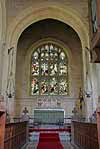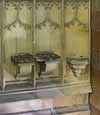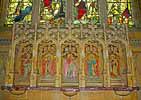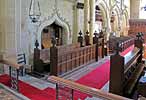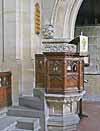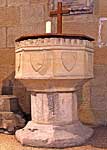For this church:    |
Colston Bassett St John the DivineFeatures and Fittings
The altar/communion table is installed on a platform of decorative Victorian tiling with coloured marble surround, it is made of a substantial wooden frame and top with plain white cloth cover and an interchangeable frontal. A simple wooden crucifix adorns the table top, the crucifix which is placed on the altar during services. It is kept safe at other times, as is the altar lectern. A long blue kneeler is placed across the altar front and has the words ‘THE BREAD OF LIFE’ embroidered across the face. There are two communion rails, one either side on the upper step, each sits upon two flat wrought iron pillars, the tops are made of oak. A red Kneeler is placed the full length of the altar step for communicants. A piscina forms part of the south wall panel of the chancel, it is a three quarter octagonal shape with a flat top on a moulded pedestal; to the side are two marble topped shelves sitting on pedestals for use in Holy Communion.
The reredos is constructed from ornately carved stone in five deep bays, it sits on three champagne glass style pillars, each bay displaying illuminated pictures of five apostles; there are two crested shields displaying appropriate motifs of each apostle in the upper section of each bay. The choir stalls are contemporary with the building, constructed of oak in the traditional style of bench with poppy heads adorning the ends, a cleric’s reading desk is at the nave end of both stalls.
The hexagonal pulpit is accessed by three stone steps. It is constructed of oak and was presented by Major George Baynton Davy, formerly of Colston Bassett Hall. The pulpit sits on Cosham Down Bath stone plinth and base with vine decoration to the upper rim and has decorated panels on the base. The main pulpit is divided into three upper panels of open tracery and three decorated lower panels; the upper rim has ‘floral’ decoration. A brass lectern with a silk drape is mounted above and illuminated with an ornamental lamp with two candle bulbs. The pews are of a plain pine wood Victorian style bench with book rests and kneeler board. The kneelers are all handmade blocks decorated with various exquisite cross stitch designs and were made by the ladies of the village. The lectern a splendid carved wooden eagle is sitting on a rotating ball and mounted on a machined wooden column supported on a cruciform base with carved decoration and trefoil on each quarter section.
There are two fonts in the church. The first and main font is situated opposite the nave door at the west end of the church at the end of the south aisle. It is octagonal with delicately carved tracery on the upper section which has a small amount of damage. The font has a lead lined bowl all mounted on an octagonal plinth. This font was the gift of Mr W K Marriott in memory of his parents. The bronze wall plaque fitted adjacent on the west wall reads:
The second font, also octagonal and of heavy carved stone, is reputed to be the font from the consolidated ruin of St Marys' church, Colston Bassett, which was replaced by the church of Saint John the Divine, and situated in the north chapel. It has eight shields carved in relief around the bowl and has a carved upper rim. The cover is flat, constructed in light oak with a simple matching wooden crucifix standing on top. Each side of this font is the section of a capital or base to an ancient column that are converted into seating. A wall hanging in the form of a processional banner hangs from the north aisle wall by the north chapel doorway. It is dedicated to St John the Divine, Colston Bassett. Two brass flower vases adorn the sill of the reredos. In the Chancel are two old carved oak chairs, one bearing the initials M.H. and I.D. and the date 1620. Church plate and other valuables are not accessible from the church. There is no evidence of a specific rood cross apart from a cross situated on the altar. There is no evidence of the existence of an Aumbrey.
|


